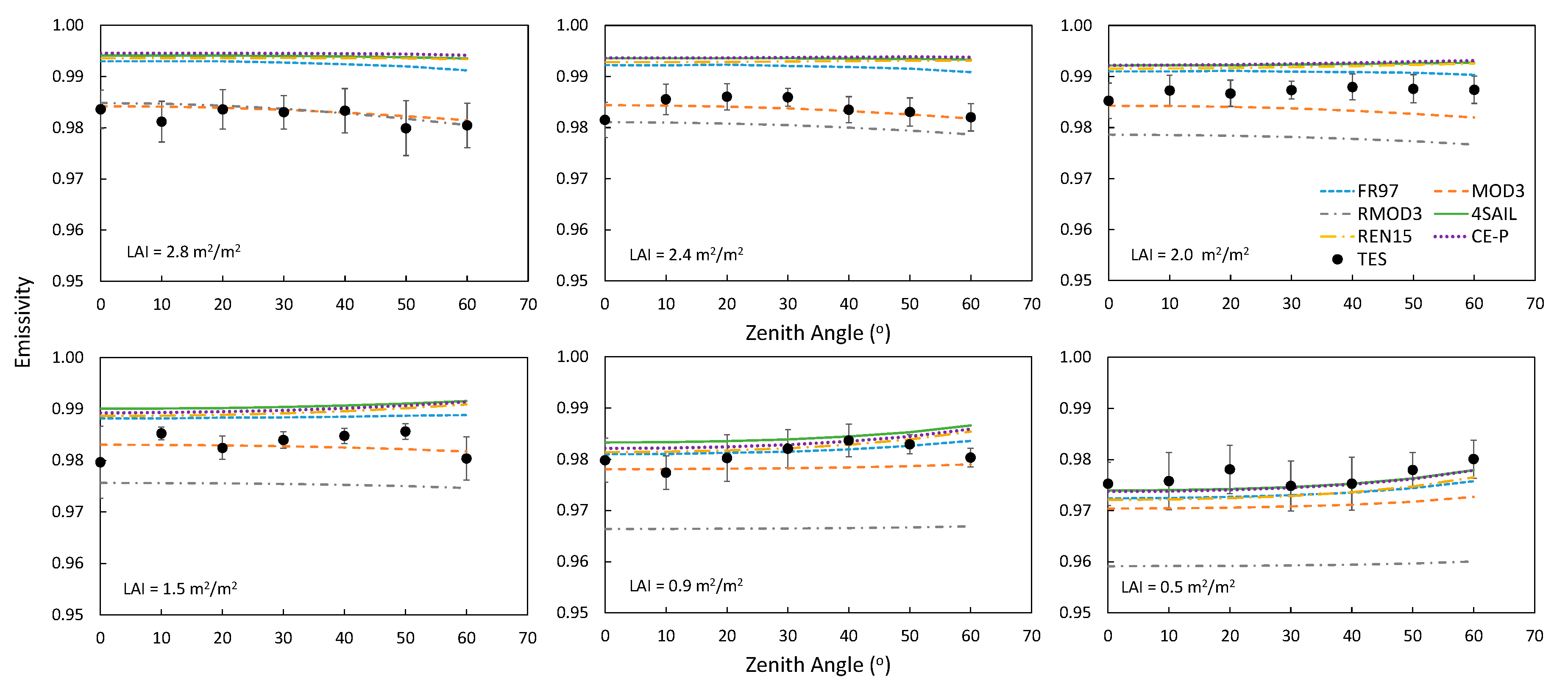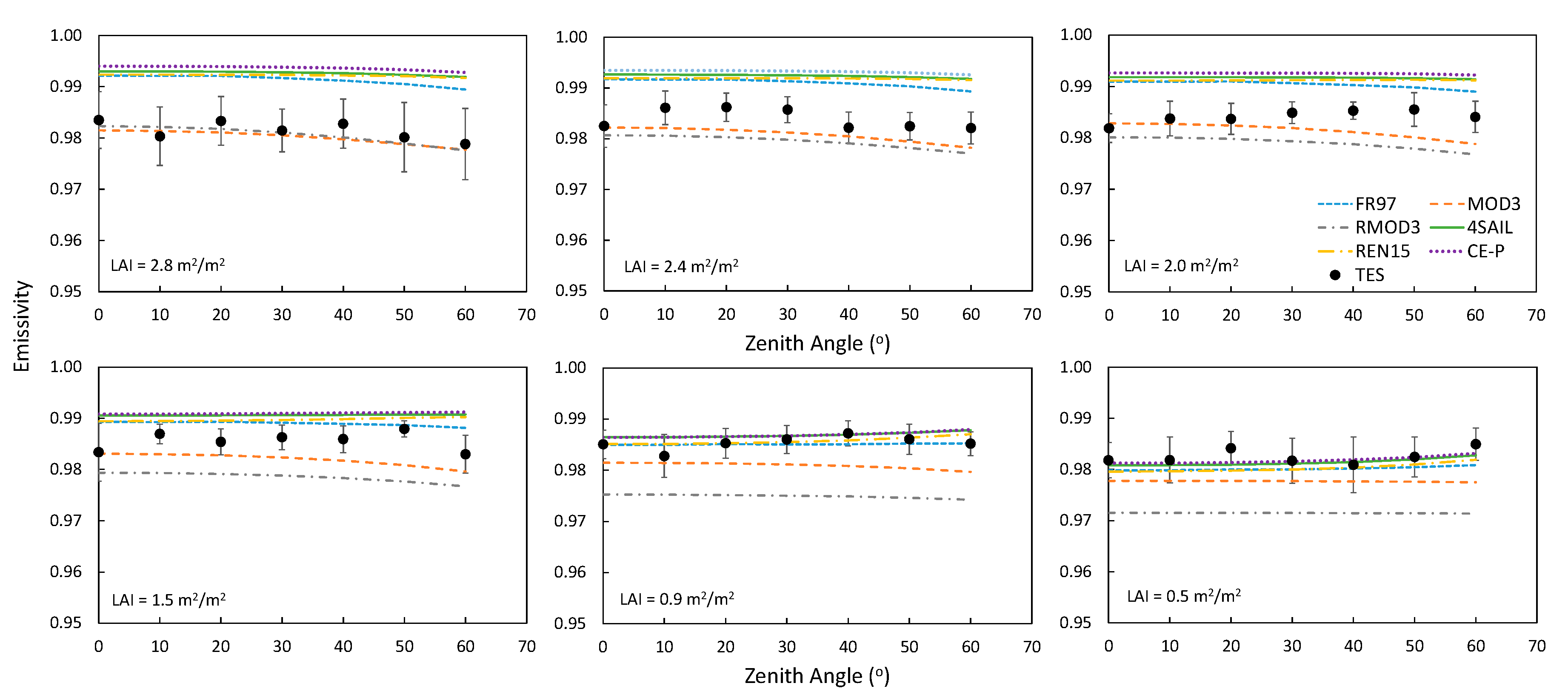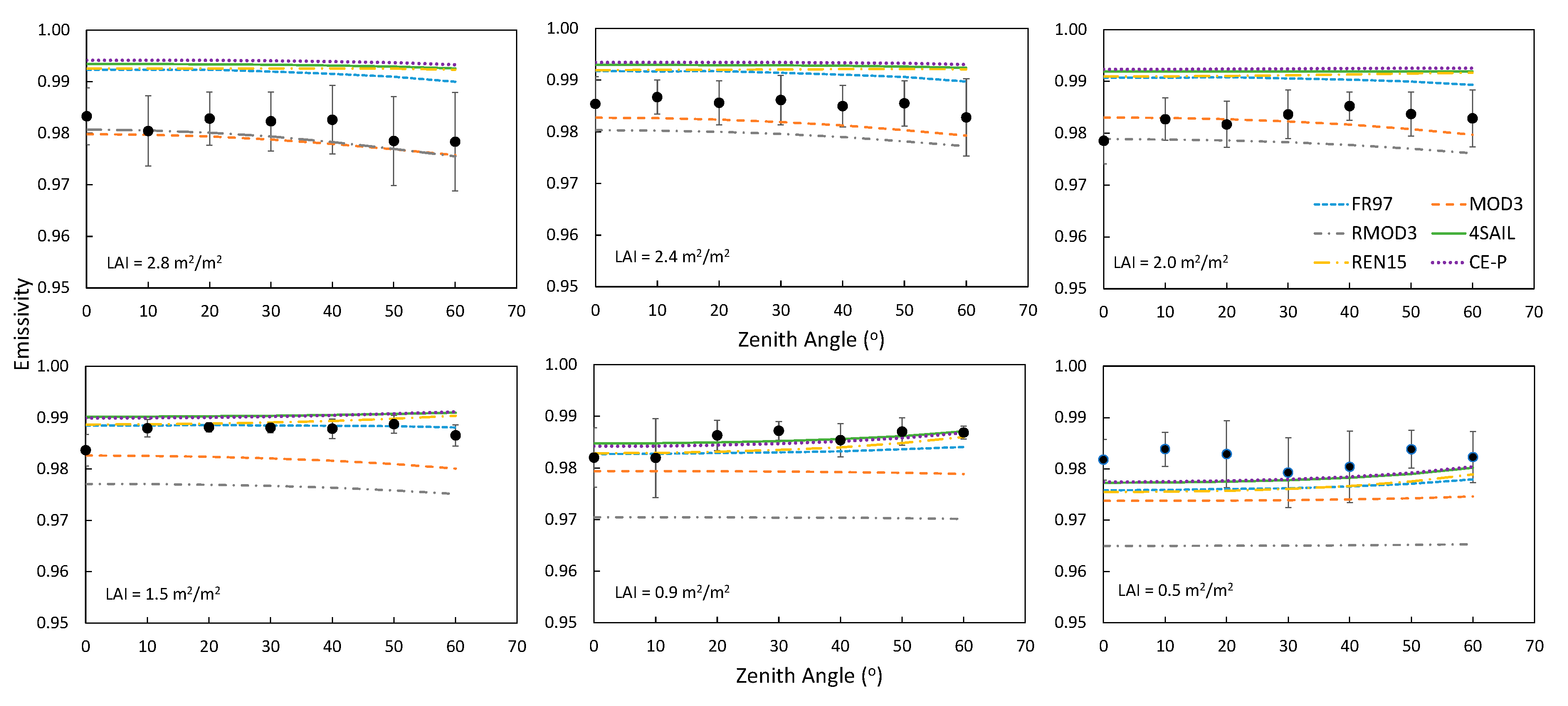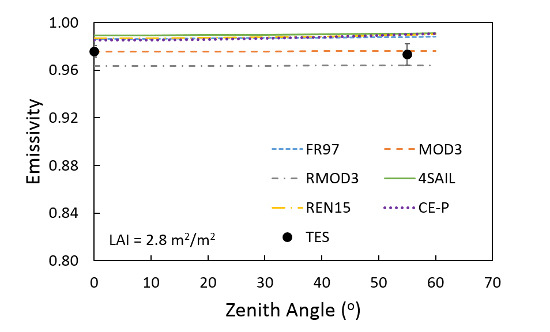Evaluation of Six Directional Canopy Emissivity Models in the Thermal Infrared Using Emissivity Measurements
Abstract
1. Introduction
2. Experimental Setup and Data Processing
2.1. Cimel ElectroniqueCE312-2
2.2. TES Algorithm
2.3. Pocket-LAI
2.4. Sample
3. Models
3.1. FR97 Model
3.2. Mod3 Model
3.3. Rmod3 Model
3.4. SAIL Model
3.5. REN15 Model
3.6. CE-P Model
4. Results
4.1. Leaf Area Index and Vegetation Cover Fraction Measurements
4.2. Canopy Emissivity Variation with LAI at Nadir
4.3. Canopy Emissivity Variation with Viewing Angle for Different LAI Values
4.3.1. Organic Soil
4.3.2. Inorganic Soil
5. Discussion
6. Summary and Conclusions
Author Contributions
Funding
Acknowledgments
Conflicts of Interest
References
- Anderson, M.C.; Kustas, W.P.; Norman, J.M.; Hain, C.R.; Mecikalski, J.R.; Schultz, L.; González-Dugo, M.P.; Cammalleri, C.; D’Urso, G.; Pimstein, A. Mapping daily evapotranspiration at field to continental scales using geostationary and polar orbiting satellite imagery. Hydrol. Earth Syst. Sci. 2011, 15, 223–239. [Google Scholar] [CrossRef]
- Sánchez, J.M.; López-Urrea, R.; Rubio, E.; González-Piqueras, J.; Caselles, V. Assessing crop coefficients of sunflower and canola using two-source energy balance and thermal radiometry. Agric. Water Manag. 2014, 137, 23–29. [Google Scholar] [CrossRef]
- Li, Z.; Tang, B.; Wu, H.; Ren, H.; Yan, G.; Wan, Z.; Trigo, I.F.; Sobrino, J.A. Satellite-derived land Surface temperature: Current status and perspectives. Remote Sens. Environ. 2013, 131, 14–37. [Google Scholar] [CrossRef]
- Salisbury, J.W.; D’Aria, M. Emissivity of terrestrial materials in the 8–14 μm atmospheric window. Remote Sens. Environ. 1992, 42, 83–106. [Google Scholar] [CrossRef]
- Baldridge, A.M.; Hook, S.J.; Grove, C.I.; Rivera, G. The ASTER spectral library version 2.0. Remote Sens. Environ. 2009, 113, 711–715. [Google Scholar] [CrossRef]
- Ullah, S.; Schlerf, M.; Skidmore, A.K.; Hecker, C. Identifying plant species using mid-wave infrared (2.5–6 μm) and thermal infrared (8–14 μm) emissivity spectra. Remote Sens. Environ. 2012, 118, 95–102. [Google Scholar] [CrossRef]
- Rock, G.; Gerhards, M.; Schlerf, M.; Hecker, C.; Udelhoven, T. Plant species discrimination using emissive thermal infrared imaging spectroscopy. Int. J. Appl. Earth Obs. Geoinf. 2016, 53, 16–26. [Google Scholar] [CrossRef]
- Labed, J.; Stoll, M.P. Angular variation of land surface spectral emissivity in the thermal infrared: Laboratory investigations on bare soils. Int. J. Remote Sens. 1992, 12, 2299–2310. [Google Scholar] [CrossRef]
- Cuenca, J.; Sobrino, J.A. Experimental measurements for studying angular and spectral variation of thermal infrared emissivity. Appl. Opt. 2004, 43, 4598–4602. [Google Scholar] [CrossRef]
- García-Santos, V.; Valor, E.; Caselles, V.; Burgos, M.A.; Coll, C. On the angular variation of thermal infrared emissivity of inorganic soils. J. Geophys. Res. 2012, 117, D19116. [Google Scholar] [CrossRef]
- Salisbury, J.W.; D’Aria, M. Infrared (8–14 mm) remote sensing of soil particle size. Remote Sens. Environ. 1992, 42, 157–165. [Google Scholar] [CrossRef]
- Mira, M.; Valor, E.; Caselles, V.; Rubio, E.; Coll, C.; Galve, J.M.; Niclos, R.; Sánchez, J.M.; Boluda, R. Soil moisture effect on thermal infrared (8–13-mm) emissivity. IEEE Trans. Geosci. Remote Sens. 2010, 48, 2251–2260. [Google Scholar] [CrossRef]
- García-Santos, V.; Valor, E.; Caselles, V.; Coll, C.; Burgos, M.A. Effect of Soil Moisture on the Angular Variation of Thermal Infrared Emissivity of Inorganic Soils. IEEE Geosci. Remote Sens. Lett. 2014, 11, 1091–1095. [Google Scholar] [CrossRef]
- Warren, S.G.; Wiscombe, W.J. A model for the spectral albedo of snow. II: Snow containing atmospheric aerosols. J. Atmos. Sci. 1980, 37, 2734–2745. [Google Scholar] [CrossRef]
- Hapke, B. Theory of Reflectance and Emittance Spectroscopy; Cambridge Univ. Press: NewYork, NY, USA, 2012; p. 455. [Google Scholar]
- García-Santos, V.; Valor, E.; Caselles, V.; Doña, C. Validation and comparison of two models based on the Mie theory to predict 8–14 μm emissivity spectra of mineral surfaces. J. Geophys. Res. Solid Earth 2016, 121, 1739–1757. [Google Scholar] [CrossRef][Green Version]
- García-Santos, V.; Valor, E.; Di Biagio, C.; Caselles, V. Predictive Power of the Emissivity Angular Variation of Soils in the Thermal Infrared (8–14 μm) Region by Two Mie-Based Emissivity Theoretical Models. IEEE Geosci. Remote Sens. Lett. 2018, 15, 1115–1119. [Google Scholar] [CrossRef]
- Cao, B.; Liu, Q.; Du, Y.; Roujean, J.L.; Gastellu-Etchegorry, J.P.; Trigo, I.F.; Zhan, W.; Yu, Y.; Cheng, J.; Jacob, F.; et al. A review of earth surface thermal radiation directionality observing and modeling: Historical development, current status and perspectives. Remote Sens. Environ. 2019, 232, 111304. [Google Scholar] [CrossRef]
- Snyder, W.C.; Wan, Z. BRDF models to predict spectral reflectance and emissivity in the thermal infrared. IEEE Trans. Geosci. Remote Sens. 1998, 36, 214–225. [Google Scholar] [CrossRef]
- Sobrino, J.A.; Caselles, V. Thermal infrared radiance model for interpreting the directional radiometric temperature of a vegetative surface. Remote Sens. Environ. 1990, 33, 193–199. [Google Scholar] [CrossRef]
- Valor, E.; Caselles, V. Validation of the vegetation cover method for land surface emissivity estimation. In Recent Research Developments in Thermal Remote Sensing; Research Signpost: Kerala, India, 2005. [Google Scholar]
- François, C.; Ottlé, C.; Prévot, L. Analytical parameterization of canopy directional emissivity and directional radiance in the thermal infrared. Application on the retrieval of soil and foliage temperatures using two directional measurements. Int. J. Remote Sens. 1997, 18, 2587–2621. [Google Scholar] [CrossRef]
- François, C. The potential of directional radiometric temperatures for monitoring soil and leaf temperature and soil moisture status. Remote Sens. Environ. 2002, 80, 122–133. [Google Scholar] [CrossRef]
- Guillevic, P.; Gastellu-Etchegorry, J.P.; Demarty, J.; Prévot, L. Thermal infrared radiative transfer within three-dimensional vegetation covers. J. Geophys. Res. 2003, 108, 4248. [Google Scholar] [CrossRef]
- Verhoef, W.; Jia, L.; Xiao, Q.; Su, Z. Unified Optical-Thermal Four-Stream Radiative Transfer Theory for Homogeneous Vegetation Canopies. IEEE Trans. Geosci. Remote Sens. 2007, 45, 1808–1822. [Google Scholar] [CrossRef]
- Shi, Y. Thermal infrared inverse model for component temperatures of mixed pixels. Int. J. Remote Sens. 2011, 32, 2297–2309. [Google Scholar] [CrossRef]
- Ren, H.; Liu, R.; Yan, G.; Li, Z.L.; Qin, Q.; Liu, Q.; Nerry, F. Performance evaluation of four directional emissivity analytical models with thermal SAIL model and airborne images. Opt. Express 2015, 23, A346–A360. [Google Scholar] [CrossRef] [PubMed]
- Cao, B.; Guo, M.; Fan, W.; Xu, X.; Peng, J.; Ren, H.; Du, Y.; Li, H.; Bian, Z.; Hu, T.; et al. A new directional canopy emissivity model based on spectral invariants. IEEE Trans. Geosci. Remote Sens. 2018, 56, 6911–6926. [Google Scholar] [CrossRef]
- Sobrino, J.A.; Jiménez-Muñoz, J.C.; Verhoef, W. Canopy directional emissivity: Comparison between models. Remote Sens. Environ. 2005, 99, 304–314. [Google Scholar] [CrossRef]
- Neinavaz, E.; Skidmore, A.K.; Darvishzadeh, R.; Groen, T.A. Retrieval of leaf area index in different plant species using thermal hyperspectral data. ISPRS J. Photogramm. Remote Sens. 2016, 119, 390–401. [Google Scholar] [CrossRef]
- Neinavaz, E.; Darvishzadeh, R.; Skidmore, A.K.; Groen, T.A. Measuring the response of canopy emissivity spectra to leaf area index variation using thermal hyperspectral data. Int. J. Appl. Earth Obs. Geoinf. 2016, 53, 40–47. [Google Scholar] [CrossRef]
- Gillespie, A.; Rokugawa, S.; Matsunaga, T.; Cothern, J.S.; Hook, S.; Kahle, A.B. A Temperature and Emissivity Separation Algorithm for Advanced Spaceborne Thermal Emission and Reflection Radiometer (ASTER) Images. IEEE Trans. Geosci. Remote Sens. 1998, 36, 1113–1126. [Google Scholar] [CrossRef]
- Coll, C.; Niclòs, R.; Puchades, J.; García-Santos, V.; Galve, J.M.; Pérez-Planells, L.; Valor, E.; Thecharous, E. Laboratory calibration and field measurement of land surface temperature and emissivity using thermal infrared multiband radiometers. Int. J. Appl. Earth Obs. Geoinf. 2019, 78, 227–239. [Google Scholar] [CrossRef]
- Legrand, M.; Pietras, C.; Brogniez, G.; Haeffelin, M.; Abuhassan, N.K.; Sicard, M. A high-accuracy multiwavelength radiometer for in situ measurements in the thermal infrared. Part I: Characterization of the instrument. J. Atmos. Ocean. Technol. 2000, 17, 1203–1214. [Google Scholar] [CrossRef]
- Confalonieri, R.; Foi, M.; Casa, R.; Aquaro, S.; Tona, E.; Peterle, M.; Boldini, A.; Carli, G.D.; Ferrari, A.; Finotto, G. Development of an app for estimating leaf area index using a smartphone. Trueness and precision determination and comparison with other indirect methods. Comput. Electron. Agric. 2013, 96, 67–74. [Google Scholar] [CrossRef]
- Korb, A.R.; Dybwad, P.; Wadsworth, W.; Salisbury, J.W. Portable Fourier transform infrared spectroradiometer for field measurements of radiance and emissivity. Appl. Opt. 1996, 35, 1679–1692. [Google Scholar] [CrossRef] [PubMed]
- Theocharous, E.; Fox, N.P.; Barker-Snook, I.; Niclòs, R.; García-Santos, V.; Minnett, P.; Göttsche, F.M.; Poutier, L.; Morgan, N.; Nightingale, T.; et al. The 2016 CEOS infrared radiometer comparison: Part 2: Laboratory comparison of radiation thermometers. J. Atmos. Ocean. Technol. 2019, 36, 1079–1092. [Google Scholar] [CrossRef]
- García-Santos, V.; Valor, E.; Caselles, V.; Mira, M.; Galve, J.M.; Coll, C. Evaluation of different methods to retrieve the hemispherical downwelling irradiance in the thermal infrared region for field measurements. IEEE Trans. Geosci. Remote Sens. 2013, 51, 2155–2165. [Google Scholar] [CrossRef]
- Coll, C.; Caselles, V.; Valor, E.; Niclòs, R.; Sánchez, J.M.; Galve, J.M.; Mira, M. Temperature and emissivity separation from ASTER data for low spectral contrast surfaces. Remote Sens. Environ. 2007, 110, 162–175. [Google Scholar] [CrossRef]
- Gillespie, A.R.; Abbott, E.A.; Gilson, L.; Hulley, G.; Jiménez-Muñoz, J.C.; Sobrino, J.A. Residual errors in ASTER temperature and emissivity standard products AST08 and AST05. Remote Sens. Environ. 2011, 115, 3681–3694. [Google Scholar] [CrossRef]
- Pérez-Planells, L.; Valor, E.; Coll, C.; Niclòs, R. Comparison and Evaluation of the TES and ANEM Algorithms for Land Surface Temperature and Emissivity Separation over the Area of Valencia, Spain. Remote Sens. 2017, 9, 1251. [Google Scholar] [CrossRef]
- Mira, M.; Schmugge, T.J.; Valor, E.; Caselles, V.; Coll, C. Comparison of thermal emissivities retrieved with the two-lid box and TES methods with laboratory spectra. IEEE Trans. Geosci. Remote Sens. 2009, 47, 1012–1021. [Google Scholar] [CrossRef]
- Gillespie, A. Lithologic Mapping of Silicate Rocks Using TIMS; TIMS Data User’sWorkshop Jet Propulsion Laboratory: Pasadena, CA, USA, 1986; pp. 29–44. [Google Scholar]
- Hulley, G.; Hook, S.J. The North American ASTER Land Surface Emissivity Database (NAALSED) Version 2.0. Remote Sens. Environ. 2009, 113, 1967–1975. [Google Scholar] [CrossRef]
- Chen, J.M.; Black, T.A. Defining leaf area index for non-flat leaves. Plant Cell Environ. 1992, 15, 421–429. [Google Scholar] [CrossRef]
- Baret, F.; De Solan, B.; Lopez-Lozano, R.; Ma, K.; Weiss, M. GAI estimates of row crops from downward looking digital photos taken perpendicular to rows at 57.5 zenith angle: Theoretical considerations based on 3D architecture models and application to wheat crops. Agric. For. Meteorol. 2010, 150, 1393–1401. [Google Scholar] [CrossRef]
- Campos-Taberner, M.; García-Haro, F.J.; Confalonieri, R.; Martínez, B.; Moreno, Á.; Sánchez-Ruiz, S.; Gilabert, M.A.; Camacho, F.; Boschetti, M.; Busetto, L. Multitemporal Monitoring of Plant Area Index in the Valencia Rice District with PocketLAI. Remote Sens. 2016, 8, 202. [Google Scholar] [CrossRef]
- Francone, C.; Pagani, V.; Foi, M.; Cappelli, G.; Confalonieri, R. Comparison of leaf area index estimates by ceptometer and PocketLAI smart app in canopies with different structures. Field Crop. Res. 2014, 155, 38–41. [Google Scholar] [CrossRef]
- Orlando, F.; Movedi, E.; Coduto, D.; Parisi, S.; Brancadoro, L.; Pagani, V.; Guarneri, T.; Confalonieri, R. Estimating Leaf Area Index (LAI) in Vineyards Using the PocketLAI Smart-App. Sensors 2016, 16, 2004. [Google Scholar] [CrossRef] [PubMed]
- Orlando, F.; Movedi, E.; Paleari, L.; Gilardelli, C.; Foi, M.; Dell’Oro, M.; Confalonieri, R.; Hermy, M. Estimating leaf area index in tree species using the PocketLAI smart app. Appl. Veg. Sci. 2015, 18, 716–723. [Google Scholar] [CrossRef]
- Prévot, L. Modélisation des Échanges radiatifs au Sein des Couverts Végétaux. Application à la Télédétection. Validation sur un Couvert de Maïs. Ph.D. Thesis, University of Paris VI, Paris, France, 1985. [Google Scholar]
- Chehbouni, A.; Nouvellon, Y.; Kerr, Y.H.; Moran, M.S.; Watts, C.; Prévot, L.; Watts, C.; Goodrich, D.C.; Rambal, S. Directional effect on radiative surface temperature measurements over a semi-arid grassland site. Remote Sens. Environ. 2001, 76, 360–372. [Google Scholar] [CrossRef]
- Verhoef, W. Light scattering by leaf layers with application to canopy reflectance modeling: The SAIL model. Remote Sens. Environ. 1984, 16, 125–141. [Google Scholar] [CrossRef]
- Guo, M.; Cao, B.; Fan, W.; Ren, H.; Cui, Y.; Du, Y.; Liu, Q. Scattering effect contributions to the directional canopy emissivity and brightness temperature based on CE-P and CBT-P models. IEEE Geosci. Remote Sens. Lett. 2019, 16, 957–961. [Google Scholar] [CrossRef]














| LAI (m2/m2)—OS | —OS | LAI (m2/m2)—IS | —IS |
|---|---|---|---|
| 2.8 ± 0.4 | 0.95 ± 0.03 | 3.3 ± 0.5 | 0.98 ± 0.03 |
| 2.4 ± 0.4 | 0.90 ± 0.03 | 2.8 ± 0.3 | 0.96 ± 0.04 |
| 2.0 ± 0.3 | 0.83 ± 0.06 | 2.4 ± 0.3 | 0.91 ± 0.05 |
| 1.5 ± 0.2 | 0.77 ± 0.05 | 1.8 ± 0.3 | 0.81 ± 0.05 |
| 0.9 ± 0.2 | 0.57 ± 0.06 | 1.1 ± 0.2 | 0.62 ± 0.03 |
| 0.52 ± 0.12 | 0.41 ± 0.04 | 0.64 ± 0.07 | 0.44 ± 0.03 |
| LAI | FR97 | MOD3 | RMOD3 | 4SAIL | REN15 | CE-P | ||||||
|---|---|---|---|---|---|---|---|---|---|---|---|---|
| bias | RMSE | bias | RMSE | bias | RMSE | bias | RMSE | bias | RMSE | bias | RMSE | |
| 0.5 | −0.005 | 0.005 | −0.007 | 0.007 | −0.016 | 0.016 | −0.003 | 0.004 | −0.005 | 0.005 | −0.003 | 0.004 |
| 0.9 | −0.0001 | 0.0012 | −0.003 | 0.004 | −0.013 | 0.013 | 0.0019 | 0.002 | 0.0001 | 0.0011 | 0.0013 | 0.0017 |
| 1.5 | 0.006 | 0.006 | 0.000 | 0.002 | −0.006 | 0.006 | 0.008 | 0.008 | 0.006 | 0.006 | 0.007 | 0.007 |
| 2 | 0.008 | 0.008 | 0.000 | 0.003 | −0.004 | 0.006 | 0.009 | 0.009 | 0.008 | 0.009 | 0.009 | 0.010 |
| 2.4 | 0.008 | 0.009 | −0.001 | 0.002 | −0.003 | 0.004 | 0.010 | 0.010 | 0.009 | 0.009 | 0.010 | 0.010 |
| 2.8 | 0.008 | 0.008 | −0.0019 | 0.003 | −0.003 | 0.004 | 0.009 | 0.009 | 0.009 | 0.009 | 0.010 | 0.010 |
| Overall | 0.004 | 0.007 | −0.002 | 0.004 | −0.007 | 0.009 | 0.006 | 0.008 | 0.004 | 0.007 | 0.006 | 0.008 |
| LAI | FR97 | MOD3 | RMOD3 | 4SAIL | REN15 | CE-P | ||||||
|---|---|---|---|---|---|---|---|---|---|---|---|---|
| bias | RMSE | bias | RMSE | bias | RMSE | bias | RMSE | bias | RMSE | bias | RMSE | |
| 0.64 | 0.003 | 0.009 | 0.001 | 0.009 | −0.047 | 0.063 | 0.010 | 0.011 | 0.003 | 0.009 | 0.004 | 0.010 |
| 1.1 | 0.007 | 0.010 | 0.003 | 0.008 | −0.039 | 0.053 | 0.013 | 0.014 | 0.007 | 0.010 | 0.006 | 0.010 |
| 1.8 | 0.008 | 0.009 | 0.001 | 0.005 | −0.025 | 0.034 | 0.012 | 0.012 | 0.008 | 0.009 | 0.007 | 0.009 |
| 2.4 | 0.009 | 0.009 | −0.001 | 0.004 | −0.014 | 0.019 | 0.012 | 0.012 | 0.009 | 0.010 | 0.009 | 0.009 |
| 2.8 | 0.012 | 0.013 | 0.002 | 0.004 | −0.005 | 0.008 | 0.014 | 0.015 | 0.013 | 0.013 | 0.012 | 0.013 |
| 3.3 | 0.012 | 0.013 | 0.001 | 0.003 | −0.002 | 0.003 | 0.014 | 0.014 | 0.013 | 0.013 | 0.013 | 0.013 |
| Overall | 0.009 | 0.010 | 0.001 | 0.005 | −0.022 | 0.036 | 0.013 | 0.013 | 0.010 | 0.011 | 0.009 | 0.011 |
| LAI | FR97 | MOD3 | RMOD3 | 4SAIL | REN15 | CE-P | ||||||
|---|---|---|---|---|---|---|---|---|---|---|---|---|
| bias | RMSE | bias | RMSE | bias | RMSE | bias | RMSE | bias | RMSE | bias | RMSE | |
| 2.8 | 0.010 | 0.010 | −0.001 | 0.002 | −0.001 | 0.002 | 0.011 | 0.011 | 0.011 | 0.011 | 0.012 | 0.012 |
| 2.4 | 0.006 | 0.007 | −0.003 | 0.004 | −0.006 | 0.006 | 0.008 | 0.008 | 0.007 | 0.008 | 0.009 | 0.009 |
| 2 | 0.005 | 0.005 | −0.004 | 0.005 | −0.008 | 0.008 | 0.006 | 0.007 | 0.006 | 0.006 | 0.007 | 0.007 |
| 1.5 | 0.003 | 0.004 | −0.004 | 0.005 | −0.010 | 0.010 | 0.005 | 0.005 | 0.004 | 0.004 | 0.005 | 0.005 |
| 0.9 | −0.001 | 0.002 | −0.005 | 0.006 | −0.014 | 0.015 | 0.001 | 0.002 | 0.000 | 0.002 | 0.0007 | 0.002 |
| 0.5 | −0.005 | 0.005 | −0.007 | 0.007 | −0.016 | 0.017 | −0.003 | 0.004 | −0.004 | 0.005 | −0.003 | 0.003 |
| Overall | 0.003 | 0.006 | −0.004 | 0.005 | −0.009 | 0.011 | 0.005 | 0.007 | 0.004 | 0.007 | 0.005 | 0.007 |
| LAI | FR97 | MOD3 | RMOD3 | 4SAIL | REN15 | CE-P | ||||||
|---|---|---|---|---|---|---|---|---|---|---|---|---|
| bias | RMSE | bias | RMSE | bias | bias | bias | RMSE | bias | RMSE | bias | RMSE | |
| 3.3 | 0.015 | 0.015 | 0.002 | 0.004 | 0.000 | 0.016 | 0.016 | 0.017 | 0.016 | 0.016 | 0.016 | 0.017 |
| 2.8 | 0.014 | 0.014 | 0.003 | 0.005 | −0.004 | 0.015 | 0.016 | 0.017 | 0.015 | 0.015 | 0.015 | 0.016 |
| 2.4 | 0.013 | 0.014 | 0.002 | 0.005 | −0.011 | 0.014 | 0.016 | 0.016 | 0.014 | 0.015 | 0.014 | 0.015 |
| 1.8 | 0.009 | 0.009 | 0.001 | 0.004 | −0.026 | 0.010 | 0.013 | 0.013 | 0.010 | 0.011 | 0.009 | 0.010 |
| 1.1 | 0.011 | 0.013 | 0.006 | 0.009 | −0.037 | 0.012 | 0.017 | 0.018 | 0.012 | 0.014 | 0.011 | 0.014 |
| 0.64 | 0.012 | 0.016 | 0.009 | 0.014 | −0.042 | 0.012 | 0.018 | 0.021 | 0.012 | 0.017 | 0.013 | 0.017 |
| Overall | 0.012 | 0.014 | 0.004 | 0.007 | −0.020 | 0.013 | 0.016 | 0.017 | 0.013 | 0.015 | 0.013 | 0.015 |
© 2019 by the authors. Licensee MDPI, Basel, Switzerland. This article is an open access article distributed under the terms and conditions of the Creative Commons Attribution (CC BY) license (http://creativecommons.org/licenses/by/4.0/).
Share and Cite
Pérez-Planells, L.; Valor, E.; Niclòs, R.; Coll, C.; Puchades, J.; Campos-Taberner, M. Evaluation of Six Directional Canopy Emissivity Models in the Thermal Infrared Using Emissivity Measurements. Remote Sens. 2019, 11, 3011. https://doi.org/10.3390/rs11243011
Pérez-Planells L, Valor E, Niclòs R, Coll C, Puchades J, Campos-Taberner M. Evaluation of Six Directional Canopy Emissivity Models in the Thermal Infrared Using Emissivity Measurements. Remote Sensing. 2019; 11(24):3011. https://doi.org/10.3390/rs11243011
Chicago/Turabian StylePérez-Planells, Lluís, Enric Valor, Raquel Niclòs, César Coll, Jesús Puchades, and Manuel Campos-Taberner. 2019. "Evaluation of Six Directional Canopy Emissivity Models in the Thermal Infrared Using Emissivity Measurements" Remote Sensing 11, no. 24: 3011. https://doi.org/10.3390/rs11243011
APA StylePérez-Planells, L., Valor, E., Niclòs, R., Coll, C., Puchades, J., & Campos-Taberner, M. (2019). Evaluation of Six Directional Canopy Emissivity Models in the Thermal Infrared Using Emissivity Measurements. Remote Sensing, 11(24), 3011. https://doi.org/10.3390/rs11243011










